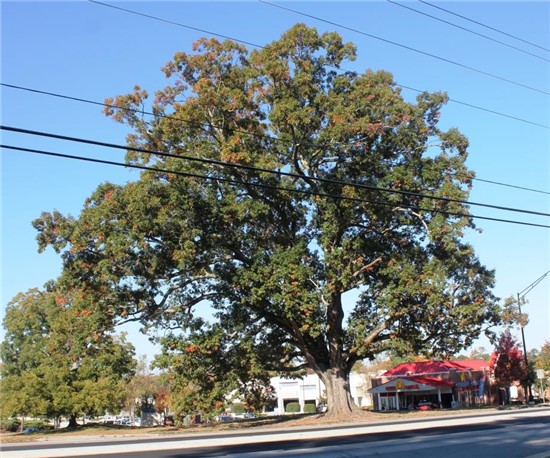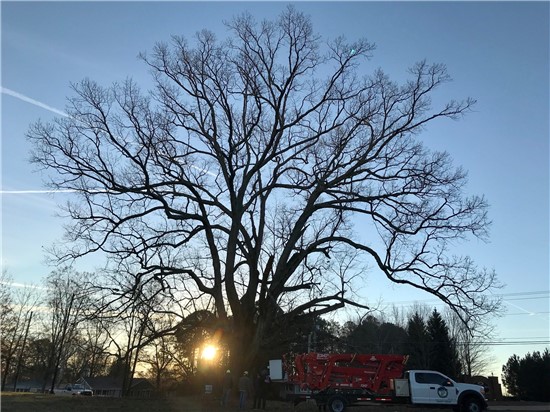Posted on: 12/28/20
 A piece of Snellville history is being removed today and tomorrow as the centuries-old Red Oak which has stood on Highway 78 since before the signing of the Constitution is coming down.
A piece of Snellville history is being removed today and tomorrow as the centuries-old Red Oak which has stood on Highway 78 since before the signing of the Constitution is coming down.
The tree, located near the Autobell Car Wash, has rotted and become hollow and has been deemed a hazard to passing motorists and pedestrians by the Georgia Department of Transportation and must come down.
A plaque which sat by the tree since 1987 reads, "The National Arborist Association and the International Society of Arboriculture jointly recognize this significant tree in this bicentennial year as having lived here at the time of the signing of our Constitution."
It is hoped both the city's Public Works Department and the Snellville Historical Society will preserve pieces of the tree and its legacy. Oak trees, acorns and leaves have been used on city logos for decades.
 "Anyone who has travelled east on Main Street in Snellville is aware of, and probably has driven under, the massive oak tree that overhangs Highway 78," Snellville historian Jim Cofer wrote in "Elegy to an Oak Tree." "Referred to by generations of old timers as 'Mr. Troy's Big Oak,' this wooden behemoth existed more than 150 years ahead of that dedicated educator, school principal, and bovine entrepreneur, Troy Thomason."
"Anyone who has travelled east on Main Street in Snellville is aware of, and probably has driven under, the massive oak tree that overhangs Highway 78," Snellville historian Jim Cofer wrote in "Elegy to an Oak Tree." "Referred to by generations of old timers as 'Mr. Troy's Big Oak,' this wooden behemoth existed more than 150 years ahead of that dedicated educator, school principal, and bovine entrepreneur, Troy Thomason."
In recent years GDOT and the city have made attempts to save the oak by minimizing disturbances to the soil around the roots and routing utilities on the other side of Main Street. However, in recent months, state arborists determined the tree is becoming hollow and poses a threat to pedestrians and drivers passing under its large heavy limbs.
Cofer said the tree still looks as it did in his school years in the 1950s and 60s.
"It would have likely been a sapling when members of the Lower Creek Native American tribe roamed the Snellville area," Cofer wrote. "Later, the Jesse Bryan family would farm the land around it in the early to mid-1800s. Jesse volunteered to fight in two different wars - the Mexican-American War and the Civil War - and ran a one-room schoolhouse between those conflicts."
 In 1920, the land came into the hands of the Brand family (as in Brand Bank- now Renasant Bank), according to Cofer. Troy and Blanche Thomason bought the 70 acres containing the oak in 1944 and farmed it part-time while teaching school until W.H. and Harold Britt bought 28 acres in 1972, and the remainder was sold for commercial development in 1990.
In 1920, the land came into the hands of the Brand family (as in Brand Bank- now Renasant Bank), according to Cofer. Troy and Blanche Thomason bought the 70 acres containing the oak in 1944 and farmed it part-time while teaching school until W.H. and Harold Britt bought 28 acres in 1972, and the remainder was sold for commercial development in 1990.
